Archive for ‘Downsizing’ Category
6 Steps to Ease Your Way Into Organizing the New Year
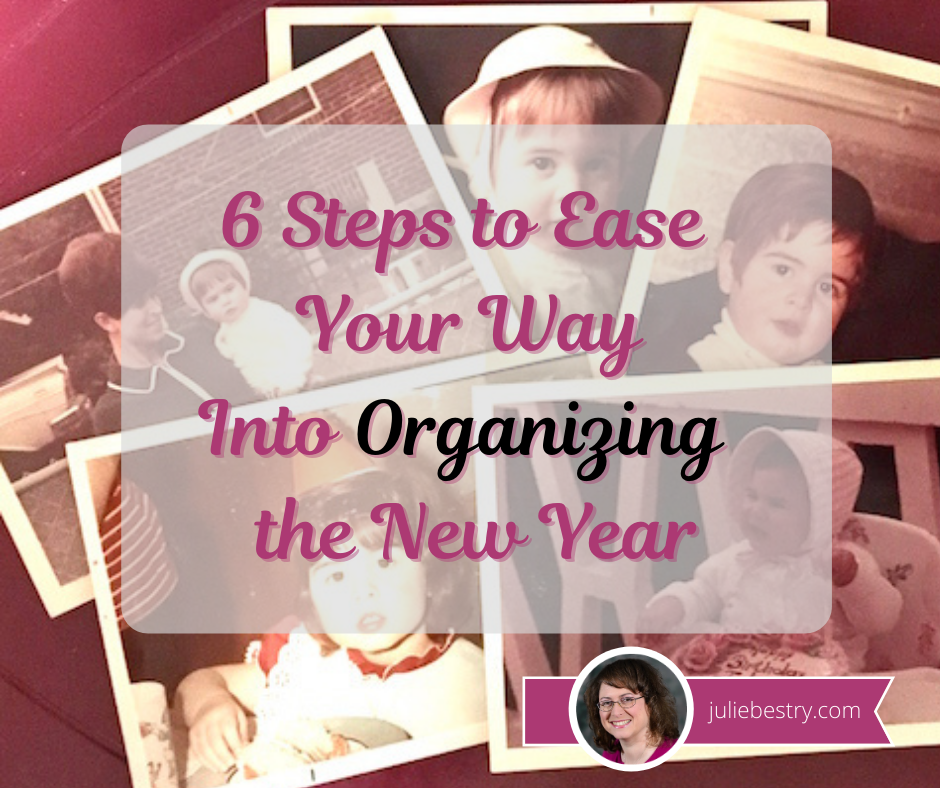
Happy New Year! Paper Doll knows that the first week of any new year (let alone after the year we’ve just escaped), can be daunting. Instead of weighing you down with homework, how about we set you up for success with some simple strategies that will ease you into a more organized approach to this year? Deal?
START WITH BABY STEPS
When it comes to clutter, it’s not the space it takes up in your house, it’s the dent it puts in your life!
When it comes to clutter, it's not the space it takes up in your house, it's the dent it puts in your life! Click To TweetIf you’re late every day because you can’t find your keys or your kids can’t find their homework, that’s a much bigger deal than a cluttered guest room closet or piles of old birthday party photos that haven’t been scrapbooked. (Need I explain to younger readers that photos used to be on paper?)

Focus on your biggest daily stressors, break them down into small, actionable steps, and solve those first.
For example, each night after dinner, sort through and declutter one kitchen drawer. When you change for bed, flip through five hangers to see what’s ready to depart. Put a table near the door for the daily launch pad of essential items you need to take with you. Hang a key hook and charging station there and make it a nighttime ritual with your kids to check that everything you’ll need the next day is there.
Don’t even know where to start? Try some of these easy options to organize your finances, your health, and your life – no heavy lifting required:
- Make a tax prep folder. Just grab a folder, label it Tax Prep 2020, and as documents start trickling in this month, you’ll at least have some place to stow them. (Don’t know what to watch for? Read last year’s Paper Doll Says the Tax Man Cometh: Organize Your Tax Forms to get a head start.)
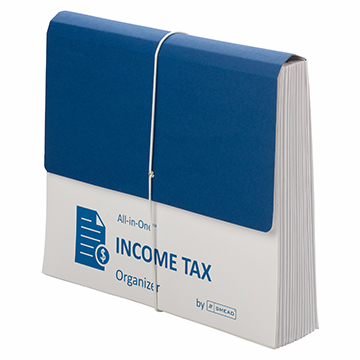
If you want to get a little more advanced, consider Smead’s All-in-One Income Tax Organizer.
- Flip through your new 2021 planner or your digital calendar to see what medical appointments are already scheduled. Make a list of all the doctor’s appointments that you need — family doctor/GP, pediatrician, dentist and orthodontist, ophthalmologist and/or optometrist, OB/GYN, and any specialists, as appropriate.
Check all those appointment cards at the bottom of your bag or thrown in the junk drawer to make sure you’ve scheduled them on your calendar. Then pick up the phone and make all the other appointments now. (Going forward, always schedule your next appointment before you leave their offices. See if you can make one day a week, like Mondays, your “appointment” day so that you’ll get it out of the way early in any week.
- Look through your wallet and VIP files to see what needs to be renewed — driver’s license, car registration, passport, etc. Instead of marking just the expiration date, make notations on your calendar to handle renewals enough in advance so nothing falls through the cracks.
GIVE UP TOLERATING WHAT BRINGS YOU DOWN
Last summer, in Organize Away Frustration: Practice the Only Good Kind of Intolerance, we talked about this at length. Take notice of the things that annoy you, whether it’s a closet too cluttered that you can’t close the door, a light fixture that keeps flickering, or a cable bill that should be renegotiated with a gentle threat to cut the cord. If something doesn’t bring you closer to the life you want to be living, make this the year you let it go. Don’t tolerate what doesn’t delight you.
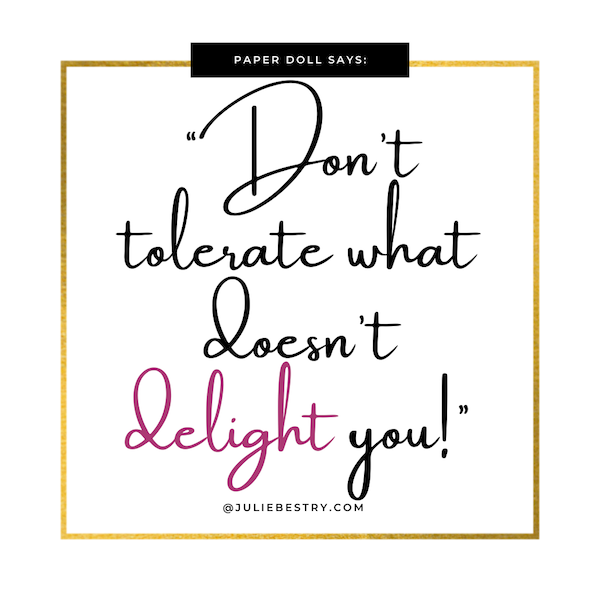
Do a brain dump. Think of a brain dump as mental hygiene, like the cognitive equivalent of brushing your teeth. Ever have the taste of garlic or fish in your mouth after dinner, such that you couldn’t really enjoy your dessert? A brain dump, where you get everything out of your head and onto paper, let’s you stop thinking of things and start thinking about them, in context. Taste your life!
Try to make a list of everything that you know you have to do in order to stop being frustrated. Go room to room and write down what you need to address. (If you’re the kind of person who really needs categories, you can create columns for things that are free or only require your own effort vs. things that require payment.)
Once you have the list, you can start working through what are immediate priorities, what’s worth scheduling, and what can go on the “I’ll do it if I’m so bored it’s between doing this task or watching paint try” list.
Feel free to tackle the tasks in any order you choose, but come up with a plan. Easiest-to-hardest helps you gain confidence; hardest-to-easiest makes everything less stressful because you’ve tackled the most difficult item first. Doing the free tasks first gives you time to budget for the more costly ones, but if you can purchase freedom from a frustration, it’ll release mental energy for other tasks.
STOP USING CLUTTER AS A TO-DO LIST
- Are you keeping a holiday gift on the dining table so you’ll remember to write a thank you note?
- Do you have boxes of donations in the middle of the hall to prompt you deliver them?
- Are you keeping a receipt to remind you to get someone to pay you back for their half of a gift (or to remind yourself to pay them back)?
- Is your unopened electric bill sitting out to remind you to pay it?
- Do you have months’ old email in your inbox hoping that keeping it there will push you to reply?
How’s that working for you? Instead, follow these steps.
- Clear your desk or a space at your kitchen or dining room table to give yourself work space.
- Take five minutes and look around the room you’re in. What do you see that’s out of place because you’re (intentionally or otherwise) using it to prompt you to do something?
- Grab a notebook and for each thing that’s in the wrong place, write down what you should be doing, instead. Yes, this gives you a To Do list that will stare you in the face (but we’ll get to that).
- Put the item away so that it’s no longer clutter.
- DO THE THING!
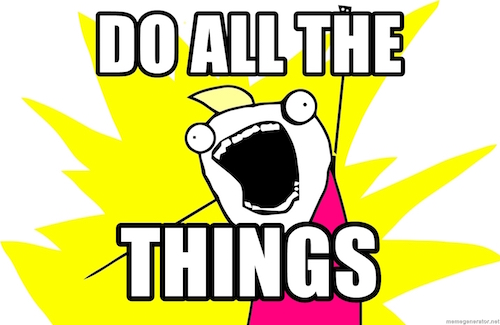
©2010 Allie Brosh, Hyperbole and a Half, via MemeGenerator
Let’s see how this works. Unpack and put away the holiday gift and go grab a notecard, envelope, return address label and stamp. Put it down on your cleared desk space.
Now, here’s the first tricky part. You can either write out the thank you note right now (check out my Gratitude, Mr. Rogers, and How To Organize A Thank You Note for guidance) and then you won’t use all your mental energy procrastinating about it, or you can put it on your To Do list. If you write the note now, you can put it on your To Do list and check it off your list, all at once, giving you an immediate sense of accomplishment! Whoohoo!
Repeat the process. Carry the donation boxes to your car, then eyeball your calendar to figure out when you can deliver the donations. Schedule the task, delegate it to a family member, or use GiveBackBox to schedule a free pickup.
And again! Use your favorite app, like Zelle, CashApp, Paypal (or ugh, fine, Venmo) to pay or request money and either file or shred the receipt as necessary. Pay the electric bill. Reply to the email or declare bankruptcy on it.
FOLLOW THE ICE CREAM RULE
So maybe your clutter is there because you don’t know where else to put it.
I tell my clients, “Don’t put things down, put them away.” By “away,” we assume you’ve already got a location in mind. Good organizing systems have two parts: the where & the how. If you bring home a bag with three items, ice cream, toilet paper, and breakfast cereal, I’m pretty sure you’re going to put the ice cream away in the freezer first (and immediately) to keep from having a melted, sticky mess. The freezer is the “where” but putting the ice cream away first is the “how.” It’s so innate, you don’t even think about.
Clutter comes from deferring that decision making. With ice cream, you don’t even have to stop and think; it’s instinct built from life-long experience. With everything else entering your home (whether a purchase, a gift, or a freebie), decide on a home before you buy or bring it in. Once it’s in your space, build time into your calendar for how/when you’ll deal with maintaining it or getting it back to where it lives.
Do you bristle at the idea of planning when you’ll do things? Maybe you feel like scheduling things belongs in the category of “budgets” and “diets” — it’s about The Man trying to keep you down!
The thing is, if you’re organized, you probably already have a system and your system feels like a safety net rather than a suffocating obligation. If you’re NOT organized, you’ll just have to trust that a system – a plan, if you will – makes life more organized so you don’t have to keep thinking about these things.
What are the triggers in your system? When will you do laundry: when the laundry basket is full or when it’s Tuesday morning after breakfast? When will you file financial papers? When your in-box is overflowing, or when your computer dings to tell you it’s 11:45a on Wednesday?
Remember: “Someday” is not a day on the calendar. Until something is innate, having an auditory or visual trigger (or both) will help remind you where and when to put things away.
REMEMBER THAT EVERYTHING SHOULD HAVE A HOME…BUT NOT EVERYTHING HAS TO LIVE WITH YOU
Systems are important, but don’t forget a universal truth: not everything you own needs to stay in your orbit forever.
Give what is no longer age-, size-, or lifestyle-appropriate new life via charity or consignment. Let it be a blessing to someone else.
Give what is no longer age-, size-, or lifestyle-appropriate new life via charity or consignment. Let it be a blessing to someone else. Click To TweetIf it’s broken and you’re not willing to spend the time or money to repair it, let it go. If you have an emotional attachment to something that’s broken, outdated, or takes up too much space to keep, take a photo of you holding it or wearing it. Then set it free!
Setting up a donation station in your home is as easy as putting a box or plastic tub in your utility room, mudroom, or garage. When you’re doing laundry or sorting through toys in the playroom, if it doesn’t fit your life, take it to the donation box right away. When the box is full, log the contents (if you’ll be taking a deduction), and send it to your favorite non-profit. Don’t wait until you have lots of boxes – one box of useful items or clothes, sent on its way, is more useful to others than mountains of boxes that never make it out of your home.
Are your file folders bulging? Do I Have To Keep This Piece of Paper? gives you a clear idea of what you need to keep and for how long. The rest? Shred and send on its way! Buh-bye!
FOLLOW THE BUDDY SYSTEM
Getting your space, time, and priorities in order can be overwhelming, but you don’t have to go it alone. For accountability and support in reaching your organizing goals, buddy up with:
- Your spouse – Trade the chore you hate (unloading the dishwasher) for the one that annoys your spouse (folding laundry) and you’re each less likely to procrastinate.
- Your kids – Make organizing a game – play Beat the Clock with your kids to see who can collect the most things that don’t belong in the living room before the song ends, and then work together to put the items away.
- Friends – Make organizing social, even when you can’t get together. Text “fashion show” photos or do a Zoom call as you organize your closets. (Friend-of-the-blog Nancy Haworth of OnTask Organizing and I did this last week! I got rid of big-shoulder-pad 80s-style blazers and she jettisoned clothes that pre-dated her strong, lithe, “certified exercise instructor” shoulders!)
- A professional organizer – As a Certified Professional Organizer®, I know how much my clients get out of having someone who knows the ropes guide them in making solid decisions and developing systems to surmount those challenging obstacles. Find a professional organizer near you by using the search function for the National Association of Productivity and Organizing Professionals (NAPO).

Speaking of which, it’s January, so that means it’s GO (Get Organized and Be Productive) Month! It’s the perfect time to focus on making your life run the way you want it to. Happy New Year, Happy GO Month, and just plain…be happy!
Paper Doll’s 6 Organizing Secrets to Kick-Start Your 2018
We’re a few days into the new year, and people are still buzzing about resolutions (Paper Doll doesn’t make them) and theme words or mantras (mine for 2018 is LAUNCH). Americans’ top New Year’s resolutions always include losing weight, straightening out finances, and breaking bad habits, but according to market research, 80% of resolutions are broken by the second week of January. It doesn’t have to be that way.
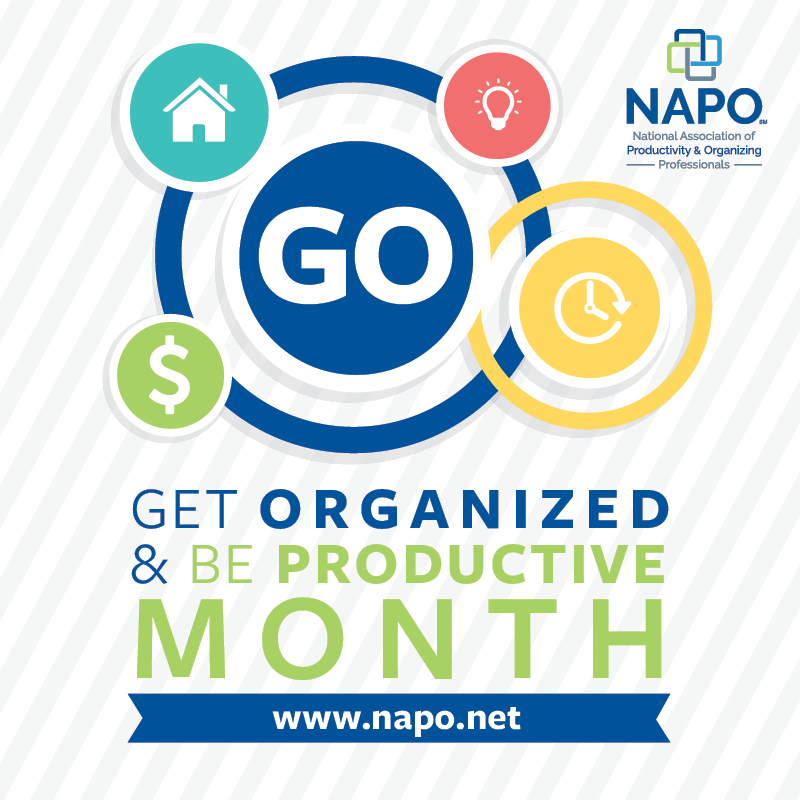
January is National Get Organized Month, and I was on my local NBC affiliate’s morning lifestyle program today, sharing my organizing philosophy and providing tips on how you can kick start your resolution to get organized this year. The conversation was free-flowing, covering some specifics of organizing, but also delving into the personal. For example, Julie Edwards, the host of 3 Plus You, asked me whether you can “make” your children become organized adults. I said that I believe that like anything else, the best way to help your children is to teach useful skills and model good behavior.
WRCBtv.com | Chattanooga News, Weather & Sports
When I was asked about how to deal with different personal organizing styles, I pointed out that within families (and with co-workers), the key is to maintain good communication, and understand that just because someone’s organizing approach is different from yours, it’s not “wrong.” It just may not be right for you.
Here are some tips I think will help you get a running start to achieving your organizing goals in 2018.
1) FOLLOW THE ICE CREAM RULE
I tell my clients, “Don’t put things down, put them away.” The word “away” presupposes you’ve already got a location in mind. But good organizing systems have two parts: the where & the how. When you bring groceries home, you put the ice cream away in the freezer immediately to keep from having a melted, sticky mess. It’s very rare for someone to put away the toilet paper or breakfast cereal before the frozen foods. The freezer is the “where” but putting the ice cream away first is the “how.” It’s so innate, you don’t even think about.
Clutter comes from deferred decision making. With ice cream, you don’t even have to stop and think; it’s instinct. With everything else in your life, when you go shopping (or even when offered things for free), decide on a home before you buy or bring it in. Once it’s in your space, build fixed time into your calendar for how/when you’ll deal with maintaining it or getting it back to where it lives. (When will you do laundry? When will you file financial papers? What will be your trigger — when the laundry basket or in-box is full, or will you put it on your calendar?)
Remember: “Someday” is not a day on the calendar.
2) EVERYTHING SHOULD HAVE A HOME…BUT NOT EVERYTHING HAS TO LIVE WITH YOU
I say this to every prospective client. The eople calling me are focused on the idea of creating systems and order, but don’t always recognize the larger truth, that not everything you own needs to stay in your orbit forever. If it’s broken and you’re not willing to spend the time or money to repair it, let it go. If you have an emotional attachment to something that’s broken, outdated, or takes up too much space to keep, take a photo of you holding it or wearing it. Then set it free!
Give what is no longer age, size, or lifestyle-appropriate new life via charity or consignment. Let it be a blessing to someone else. Setting up a donation station in your home is as easy as putting a box or plastic tub in your utility room, mudroom, or garage. When you’re doing laundry or sorting through toys in the playroom, if it doesn’t fit your life, take it to the donation box right away. When the box is full, log the contents (if you’ll be taking a deduction), and deliver it to your favorite non-profit. Don’t wait until you have lots of boxes – one box of useful items or clothes, sent on its way, is more useful to others than mountains of boxes that never make it out of your home.
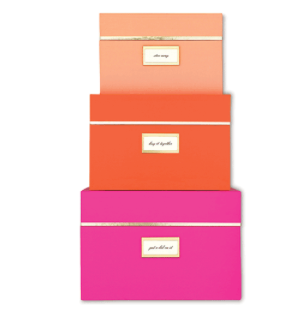
3) DON’T FIGHT CLUTTER WITH MORE CLUTTER
I love The Container Store as much as the next professional organizer. But buying oodles of storage containers – bins, boxes, tubs, and shelves – can only help you organize if you pare down to what you need and want.
Think of it this way: when you see a great outfit at the store, it’s not realistic to say, “Hey, I’ll buy this now and then lose 30 pounds to fit into it.” Even if you do declutter the personal poundage, you never know from where, exactly, that weight will disappear, so shouldn’t buy the new outfit hoping you’ll lose weight in the right places to fit into it.
I’m not saying not to acquire storage containers, but don’t do it first. Once you pare down, pick colorful, fun containers that suit your needs, space, and tastes.
4) TAKE BABY STEPS & DECLARE SMALL VICTORIES
When it comes to clutter, it’s not the space it takes up in your house, it’s the dent it puts in your life! If you’re late every day because you can’t find your keys and your kids can’t find their homework, it’s a much bigger deal than a cluttered guest room closet or drawers of old birthday party pictures that haven’t been scrapbooked.
Focus on your biggest daily stressors, break them down into small, actionable steps, and solve those first. You don’t need to do it all at once, but if you develop a habit of doing a little bit at a time, once your space is straightened up, maintenance will feel natural.
Go through just 5 hangers or one drawer each night. Clear a counter for the daily launch pad of essential items to get out the door. Hang a key hook by the front door and make it a nighttime ritual with your kids to check everything is there that you’ll all need the next day.
5) DECLARE BANKRUPTCY ON CLUTTER DEBT & STOP FEELING GUILTY!
Give yourself permission to declare bankruptcy on the “debt” of unworn clothes three sizes too small or catching up on reading months of magazines. Holding onto something just because you spent money on it or because it was a gift doesn’t make it any more valuable or useful; it just ends of costing you time (dusting or caring for it), space (that you could use for more important things), or money (spent on dry-cleaning or storage rental).
If you’re overwhelmed with thousands (or tens of thousands) or unread emails, magazines, catalogs, junk mail, or check out the classic Paper Doll post, A Different Kind of Bankruptcy, to give you some step-by-step action items.
Don’t feel guilty! Remember, supermodels on those magazine covers are airbrushed and Photoshopped. They don’t really look like that. The same is true with the rooms you see in home and garden magazines. Nobody actually lives in spaces like that – those rooms were specially designed and curated to look “perfect.” No dual-career families with toddler toys and pre-teen soccer team sleepovers live in those magazine homes. Cut yourself some slack.
6) FOLLOW THE BUDDY SYSTEM
Getting your space, time, and priorities in order can be overwhelming, but you don’t have to go it alone. Weight Watchers and 12-step programs succeed because they give people accountability and support. To help you reach your organizing goals, buddy up with:
- Your spouse – Trade tasks you don’t particularly love (like laundry for balancing the checkbook) and you’re less likely to procrastinate on doing what you enjoy.
- Your kids – Children love to “catch” adults breaking the rules and best them at competitions. Make organizing a game – play Beat the Clock to see who can collect the most things that don’t belong in the living room before the song ends, and then work together to put the items away. Make a rule that anything found on the wrong level of the house goes in a basket by the stairs, and everyone must take something (one item for little ones; the whole basket for grownups), and let everyone have a chance to “blow the whistle” on those who forget.
- Friends – Make organizing social. Invite a friend over for lunch and to help organize your closet or kitchen this weekend. Then do the same for your friend’s pantry or laundry room next week.
- A professional organizer – As a Certified Professional Organizer®, I know how much my clients get out of having someone who knows the ropes guide them in making solid decisions and developing systems to surmount those challenging obstacles. Find a professional organizer near you by using the search function for the National Association of Productivity and Organizing Professionals (NAPO).
May you have a happy, healthy, and organized 2018!
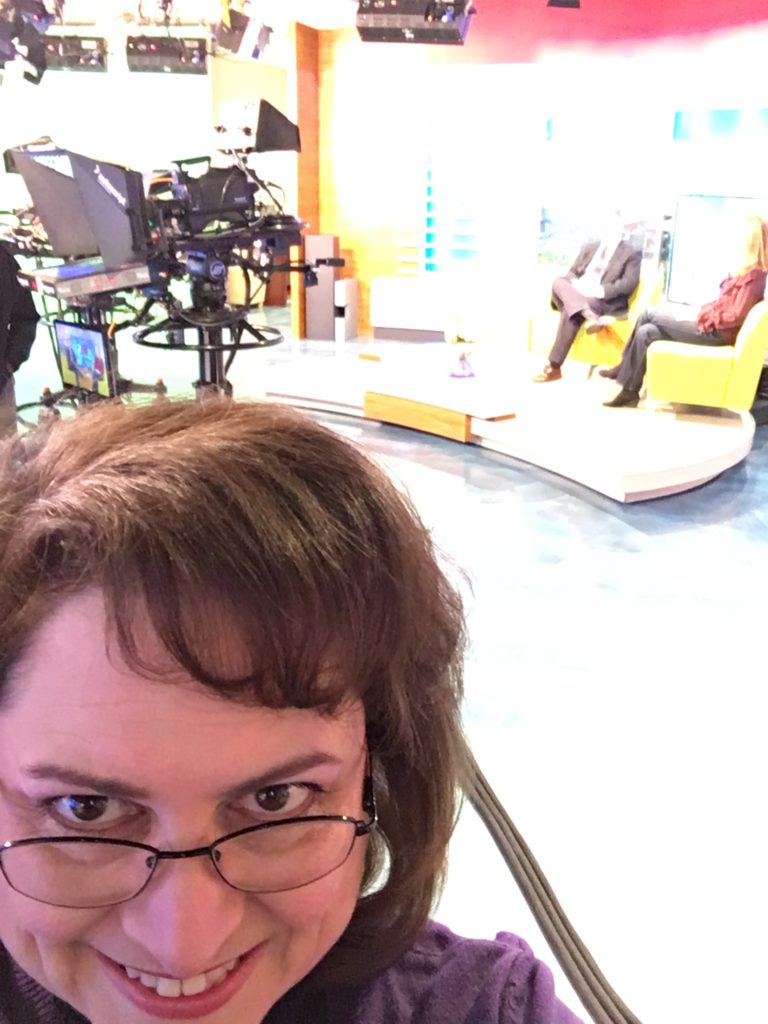
Paper Doll Doubles Down on Downsizing: Chattanooga-area Event
In this space, we usually talk about organizing paper, information, and finances. Of course, we often dig deeply into the intellectual and emotional reasons why we keep clutter, and how we can best arrange what’s left. But if you spend any time peeking behind the curtain here at Best Results Organizing (that’s Paper Doll HQ to you blog readers), you know that my services and expertise extend beyond on the realm of paper and information.
Over the past few years, one arm of my business has focused on helping individuals and couples downsize to prepare for the next stages in their lives. Sometimes, this is just clearing the decks to make room for more of the fun stuff of retirement. Other times, it’s in preparation for a move — to a smaller home or senior living. This has included a variety of speaking engagements, including the following upcoming presentation.
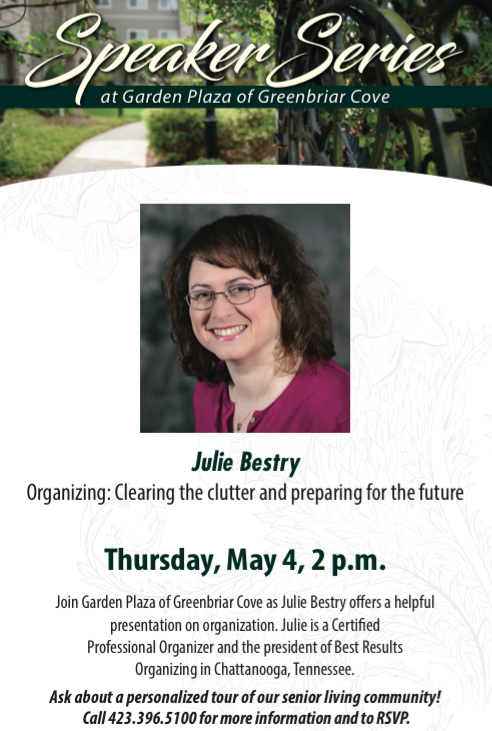
If you find yourself in the Chattanooga, Tennessee or North Georgia area, please consider attending. The presentation will cover:
- All the reasons why it’s so difficult to let go of things, even things we know we don’t need and won’t use
- How to understand the three types of relative value of the things you might downsize — sentimental value, financial value, and practical value
- What goes into determining marketability of the items you might want to sell, including rarity, age, and condition, and why not everything “old” is an antique, and not everything collected is a “collectible”
- Strategies for coping with the stresses of downsizing
- How to choose where downsized items should go when they leave your home
- and much more…
So, if you are starting to think about downsizing for the next stage in your life, and you’re in Paper Doll‘s general geographic area, please call Garden Plaza to RSVP.
Of course, that’s not all that’s going on for Paper Doll. I’m spending this week in Pittsburgh with my fabulous colleagues at the National Association of Professional Organizers Annual Conference and Expo. I’m looking forward to telling you about all the organizing wonders I see and what we learn in our classes.




Follow Me